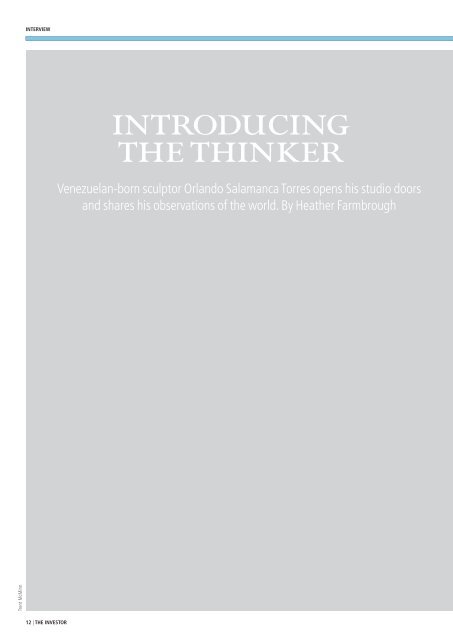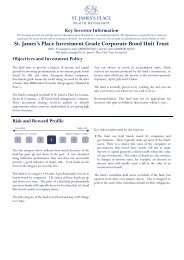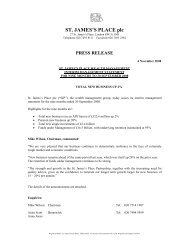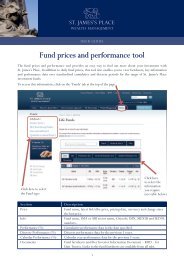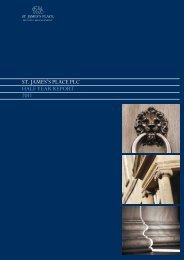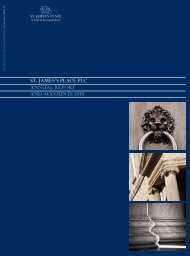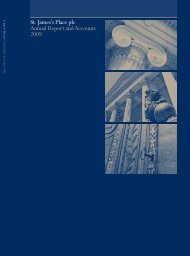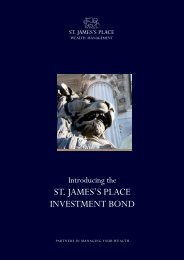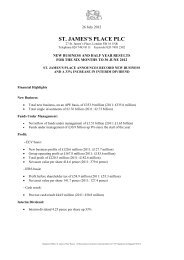Summer Investor Magazine - St James's Place
Summer Investor Magazine - St James's Place
Summer Investor Magazine - St James's Place
You also want an ePaper? Increase the reach of your titles
YUMPU automatically turns print PDFs into web optimized ePapers that Google loves.
interviewinterviewTrent McMinnintroducingthe thinkerVenezuelan-born sculptor Orlando Salamanca Torres opens his studio doorsand shares his observations of the world. By Heather Farmbroughorlando salamanca torresThe first thing that strikes you when walking into Orlando Salamanca Torres’ studio inSouth East London is a red ladder with a series of small grey men trying to climb itssteps. Every clay figure is different. If they fall, they break. Each is modelled withprecision. There are fewer at the top than the bottom, I observe. ‘Yes, the top is only forthe special people,’ Salamanca Torres jokes. ‘Other people don’t make it.’Some are climbing up boldly, others are scrambling. One man looks sad; he ishunched over, looking at the floor. He is based on a homeless man Salamanca Torres hasseen in Soho. ‘He’s there, but he’s not there,’ explains Salamanca Torres. ‘The ideacomes from the concept of time in our daily lives. We all have a ladder to climb. It’s allabout the rush to arrive somewhere, the hurry.’The next thing that catches your eye is the reclining sculpture of a young manlistening to music on his headphones, his eyes shut. The colour is striking: deep pink,inspired by a trip to India. It lights up the studio and the grey skies outside thewindow. Salamanca Torres has intentionally captured the man’s detachment from hisenvironment. ‘With headphones on, you are in another world,’ he observes. ‘I see peopleon the Tube with their headphones on and they are not aware of what is happeningaround them. When I see young women at 10 or 11 o’clock in the evening walking outof a station completely unaware of their surroundings, I think they are vulnerable. I ask,what are we missing when we detach ourselves from our surroundings?’Salamanca Torres describes his work as a series of postcards, capturing how peoplebehave in cities. ‘Culturally, we are getting more homogenous – that’s globalisation,’ henotes. ‘We wear the same things from city to city; we behave in a similar way. Yet thereality is that we also detach ourselves more and more from our environment.’He was born in Venezuela, but regards London, where he lives with his partner, ashome. He has had a studio at Acme, the largest affordable artists’ studio in London, for13 years. It has no central heating and is freezing, even in summer.Salamanca Torres qualified as an artist at Central <strong>St</strong> Martins College of Art andDesign and as an architect at London Metropolitan University. Everything he makes isunique and although he will use the little grey figures again, it will be in a different way.Each work takes a long time to complete; the ladder and the men took two years.The studio is his shop window – he sells everything he makes. How does he cope withwhat is a very uneven income stream? ‘You build a following of clients over the years,’ hereplies. ‘You have to have a group of works that are in evolution. You don’t have a goodmonth and a bad month; you have a good year and a bad year. It’s about planning.’A friend of Salamanca Torres’ partner recommended <strong>St</strong>. James’s <strong>Place</strong> in 2007 andhe has been a client ever since. ‘You have to manage whatever you have and you have tohave a professional and non-emotional portrayal of what is happening economically andfinancially. You need to have someone with a cool head and to be very aware of the facts.I think <strong>St</strong>. James’s <strong>Place</strong> is very good at that. You develop a sense of trust with your<strong>St</strong>. James’s <strong>Place</strong> partner; mine is Nick Cummins.’Salamanca Torres pays particular attention to building up his pension. ‘You have toplan well, especially as an artist. In other countries, artists have far more support – notentirely financially, but with legislation that developers have to include art in theirdevelopments, and investment in art in public spaces and that kind of thing.’He is a careful listener and thinks very deeply about issues; he welcomes debate butis reluctant to impose his own views. In this sense, he is ideally suited to his profession.‘Once you are in this profession one of the first things you have to do is to learn toobserve. The difficult part is trying not to take sides. I am very cautious of makingstatements that influence people. I am just someone who is reflecting what I see andother professions could probably benefit from that kind of lateral thinking.’INFOprINcIpal EXhIbITIONs2013‘View from the Tip of the Dog’sNose’, Royal Opera Arcade,London1998‘Hands in the Forest’ installation,Barrandov <strong>St</strong>udios, Prague1995‘Unknown’, The London Groupbiennial Open, Barbican, London1994‘Movimiento’ combinedexhibition, The ArchitecturalAssociation Gallery, London1994Cohn and Wolfe Exhibition,London – first prize for sculpturewith ‘1+1=1’Peak 201312 | tHe inve<strong>St</strong>OrNEXTtHe inve<strong>St</strong>Or | 13


